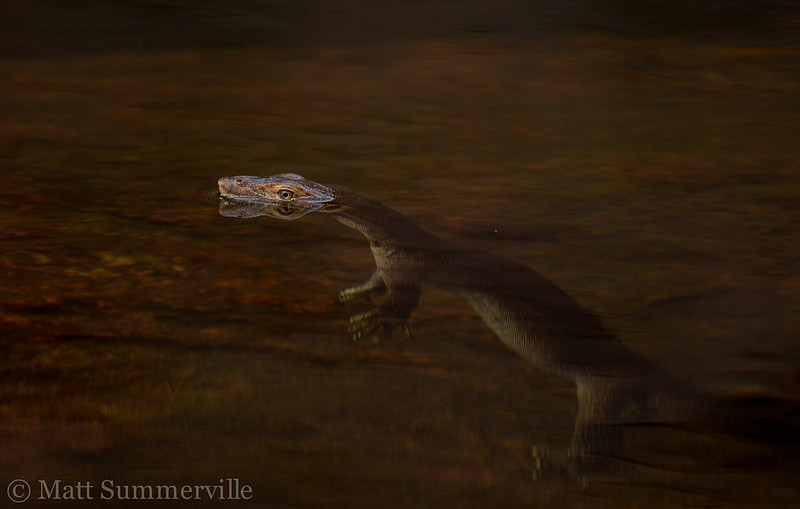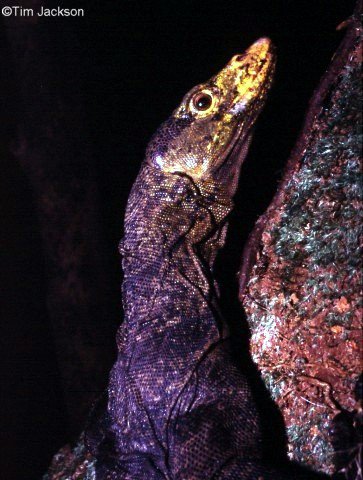Are monitor lizards venomous? (the Tale of Toxicofera, part 4)
This week, we’re going to court controversy once again by asking whether or not monitor lizards (goannas) are venomous. This post is dedicated to the memory of my long-time friend and mentor Daniel Bennett.
I was intending to follow last week’s discussion of the dental glands of toxicoferan lizards with a discussion of the oral glands, in particular the venom glands, of snakes. Dental glands have been described as “incipient” venom systems, meaning that they may represent the ancestral condition that the functional venom systems of venomous lizards and snakes evolved from. Another way of thinking about this is considering dental glands “exapted” for the evolution of venom systems. Exaptation is going to be a recurrent theme throughout the next few articles, so be sure to read the previous instalments if you need a refresher. Anyway, so much for what was intended! I’ve decided instead to dive straight into the controversial topic of the alleged “venomosity” (no, that’s not a real word) of monitor lizards. Not only is this a potentially exciting and click baity topic – who doesn’t love stirring up a hornet’s nest (not literally, even “murder hornets” have a right to peace and quiet)? – but it follows logically from last week’s discussion of dental gland anatomy.
A beautiful sand goanna (Varanus gouldii). Monitor lizards have excellent eyesight during the day, but are "night blind" as their retinas are purely composed of cone cells and lack rods, which are the low-light receptor cells responsible for night vision in other animals. Photo: Matt Summerville.
Quick refresher time! Monitor lizards are members of the family Varanidae – in Australia we call them “goannas”. Actually, there’s one species – the Bornean earless monitor (Lanthanotus borneensis) – with a family all to itself (Lanthanotidae), but we’re going to uphold the tradition of neglecting that species by ignoring it here. Australia is home to roughly half the world’s species of varanid lizard, and most of the new species discovered in recent years have come from eastern Indonesia (“Wallacea”) and New Guinea, which are part of the Australasian bioregion. Monitor lizard dental glands are located on their lower jaws (mandibles) and contain distinct regions for the secretion of proteins and mucous. The protein-secreting regions are confined to the lower half of the gland and contain “lumens” in which protein-rich secretions can be stored, ready to be deployed. The venom glands of snakes, which are composed almost entirely of protein-secreting cells, also typically have such lumens (though they vary greatly in size). This makes sense, because venom is the type of secretion that an animal might want to produce ahead of time and store, waiting for an opportunity to use it in a predatory or defensive exchange with another animal.
Like snakes, monitor lizards such as this Asian water monitor (Varanus salvator), have a forked tongue that they use to "taste" the air. This acute chemosensory capacity is a major part of their foraging behaviour. Photo: Wiki Commons.
So, goannas have dental glands that are somewhat similar to the venom glands of snakes. Snakes and goannas share an ancestor (the most recent common ancestor of Toxicofera) that had dental glands, and thus the venom glands of snakes and the dental glands of goannas (which, incidentally, are called the “glands of Gabe”) are descended from the same structures in that common ancestor. This means the glands are “homologous”, as opposed to “analogous”, the latter being a term we might apply to similar structures that converged on that similarity from disparate origins. Naturally, we can consider homology and analogy (or “homoplasy” – structures that converge due to a shared function) on multiple levels and conclude that some features, such as the fact that they are dental glands, result from shared ancestry (i.e. are homologous) and some, such are the presence of lumens, are convergent (i.e. analogous or “homoplasic”). Regardless, the $32,000 question is whether or not the similarities between the glands of Gabe and snake venom glands should be considered evidence that monitor lizards are venomous. As usual, the answer is that whilst the similarities in structure are a compelling clue about similarities in function (i.e. venom production and delivery), they are not in themselves conclusive evidence. For that, we’ll need to keep digging.
Monitor lizard eggs have long incubation periods. Some species, like this heath monitor (Varanus rosenbergi) near Sydney, have successfully adapted to (relatively) cool regions by adopting an interesting nesting strategy. Laying their eggs within termite mounds assures a relatively constant temperature throughout incubation - these lizards are taking advantage of the architectural thermoregulation technology of a social insect. Photo: David Kirshner.
Monitor lizard dental glands are even more similar to those of their relatives in the family Helodermatidae. No one seriously doubts that the gila monster (Heloderma suspectum) and beaded lizard (Heloderma horridum) are “venomous”. Helodermatidae is more closely related to Anguidae (don’t worry, there isn’t a test on these names) than it is to Varanidae, and that’s interesting because most anguid lizards don’t seem to have such highly derived glands. This suggests that similarities between helodermatid and varanid lizard glands are (somewhat) convergent, and maybe this is because they share a function (i.e. the convergence is “homoplasic”). Score another point, in that case, for monitor lizard “venom”? Well, helodermatid lizards have teeth more obviously specialised for venom delivery than goannas do, and they are responsible for many “medically significant” and even fatal envenomings of humans. The same cannot be said for monitor lizards (although see below for more controversy!).
The next line of evidence comes from the kinds of molecules produced by the various dental/venom glands of all these critters. It turns out that monitor lizard dental glands possess the genetic capacity to produce many molecules that are from well-known families of “toxin”. In other words, they express genes from families that encode toxins that are well known to be utilised in the venom of Heloderma and snakes. This then, seems like a smoking gun! Well, again not quite – toxins are typically “recruited” from gene families that are widely expressed in many tissue types and across many species. The gene families that include toxins encode many molecules that are not themselves toxins, and this actually underlies some of the broad effectiveness of venoms that contain these toxins (much more on this in future posts). Toxins must interact with molecules in the organisms they are being used against, and they typically do this by either mimicking those molecules or simply by being those molecules, albeit slightly modified and altogether nastier versions of them. Add to this the fact that secretory tissues are notably unfussy about the genes they express and the fact that reptile toxins are most likely to become toxins because they were expressed at some level in the oral glands in the first place. It looks like the evidence is still fuzzy at this point, so let’s keep digging.
The spotted tree monitor (Varanus scalaris) is a small goanna (up to approximately 45cm including the tail). As the name suggests, these lizards spend much of their time in trees. Unusually for a small goanna, they have serrated teeth, which may be useful for dismembering large insects, or in combat with members of their own species. Image: Matt Summerville.
One way to ask whether or not a particular gene encodes a toxin is to investigate whether it is more closely related to those members of its family that possess a previously verified function in venom, or to those that have some regulatory “endophysiological” role. This is a reasonable strategy but it’s inconclusive in-and-of-itself and can also easily be misled (like pretty much everything in science) by “selection bias”. If most of the sequences we have from a particular gene family in (e.g.) toxicoferan reptiles come from investigations of venom systems, this can bias our estimations of relatedness or shared functionality when we investigate additional sequences from this gene family. This is a complicated subject that we’ll delve into in future posts, but for now suffice it to say just because a new gene we have sequenced appears to be closely related to the sequences of known toxins, this is not, in isolation, evidence that the new sequence itself encodes a toxin.
A more promising line of investigation is, or would seem to be, activity. This could either be the activity of a secretion (e.g. monitor lizard spit) or of a purified component from that secretion (e.g. a single type of protein found in monitor lizard spit). Presumably, if we test that substance in the lab and demonstrate that it possesses activities consistent with those of a “venom” (i.e. it does something “toxic”), this is strong evidence that the substance or the secretion we purified it from is “venom”? If only science were that simple! In fact, lots of substances have activities in vitro (basically “in a test tube”) that they do not have in vivo (in a living organism) and even in vivo laboratory results do not directly translate to evolutionary/ecological/clinical realities. This is a typical challenge for the science of pharmacology, which is concerned with drugs and their effects, i.e. with physiologically active molecules. It’s why a candidate medicine has to go through several rounds of “pre-clinical” testing before eventually making it to the “clinical trial” phase that it must pass through before it can become an approved drug. The vast majority of “lead compounds” that have promising effects in the laboratory never become approved drugs. Of course, a prospective drug faces obstacles (e.g. safety) to its approval that are different from those faced by researchers trying to establish a functional role in venom for a particular molecule, but overall the challenges are more similar than you might think. At the end of the day, researchers are asking whether the molecule (or the secretion as a whole) is capable of having the “desired” (i.e. marketable, or selectable in the evolutionary case) effect on a target organism (a sick human, or a potential meal/predator).
Monitor lizards are typically generalist feeders and will eat anything they can overpower. Many species are specialised inhabitants of particular environments, however, such as this rusty monitor (Varanus semiremex) in the mangroves. This diversity of habitat specialisation leads to diversity in the prey items typically consumed by monitor lizard species. Photo: Matt Summerville.
So, your lead compound or mixture of compounds (lizard spit!) does something in an in vitro assay. That’s great, what next? Questions need to be asked. Examples include the “bioavailability” of the compound – this is important for drugs, but also for toxins. Is enough of the compound going to get to its target(s) in the organism via an available delivery mechanism (orally in the case of some drugs, via a bite in the case of lizard spit)? In in vitro assays, we typically expose a certain concentration of a candidate substance to its targets directly. Often the substance and its target are the only things in the “petri dish” (although tissue- and organ-based assays are points further along the spectrum towards in vivo). This is markedly different from the biological reality in which a substance not only has to enter the system of the target organism at a high enough concentration (so the amount of the substance in the spit matters), but has to maintain that “high enough” concentration until it reaches its target, despite the potential of bumping into literally every other molecule that is in the organism. That is a lot of things to bump into. If the substance interacts with some of the things it bumps into other than its intended target, this can have serious consequences. For drugs, such a consequence is so-called “off-target effects” (which includes some, but not all, “side effects”). For a hopeful toxin, this may just mean dilution and ultimately a lack of selectable effect. Another important consideration is the time it takes for the substance to take effect. Some drugs (e.g. certain antidepressants) may take weeks to become effective, and thus are not suitable for treating acute conditions. Similarly, if a toxin causes a slow death during which the intended prey item can escape beyond the reaches of the venomous predator, or during which the predator can more easily subdue it by other means, it might not have an effect that is selectable for usage as a toxin.
All these considerations add up to the conclusion that no single line of evidence can answer the question of whether or not monitor lizards (or any other animals) are “venomous”. Having a likely anatomical arrangement is a good start, as is demonstrated evidence that that anatomy produces substances that exert toxin-like effects. At the end of the day, however, whether or not an organism is venomous is a question about its ecology – the way it interacts with other organisms. There are three recognised functions of venoms – prey subjugation (subduing prey), predator deterrence, and competitor deterrence. Oral secretions like monitor lizard spit may have additional functions like lubrication, oral hygiene (e.g. they may be antimicrobial), or pre-digestion, but these are general functions of oral secretions and not functions that are in themselves characteristic of “venom”. Toxic activities established in the laboratory are sometimes referred to as “functions”, but this is inaccurate in a biological context. Unfortunately, in different but related fields of science we use the same words with somewhat different meanings. Protein chemists and pharmacologists who love biologically active molecules but often do not consider the actual biology (evolution and ecology) that produces them, often refer to mere activity as “function”. This is misleading and I wish they would stop….despite the fact that part of my work is as a protein chemist in a pharmacology department. In evolutionary biology, we distinguish functions from “properties”. Functions are that subset of properties (which are just whatever attributes a given thing has) which are actually playing a selectable role in the life history of the organism that possesses them. Many substances in nature (and under your kitchen sink) are toxic, but “venom” is a functional trait…..you know the rest (you can click here if you don’t).
A hatchling heath monitor (Varanus rosenbergi) emerging from a termite mound near Sydney. Sometimes additional features of an animal's anatomy can shed light on whether or not it is venomous or poisonous. Some have suggested that the stunning bright orange colouration of hatchling heath monitors, which fades over time, may be "aposematic" - warning colouration which functions as an advertisement of their venomous bite. This seems unlikely, however, as the orange which looks so bright against certain backgrounds functions as excellent camouflage as soon as the lizards reach the litter of fallen leaves in which they forage. Photo: David Kirshner.
All of the above, then, contributes to the fact that it’s still controversial whether or not monitor lizards are venomous. In general, people who place more emphasis on molecular and pharmacological sources of evidence have argued that they are, whereas organismal biologists, who study the animals in the field or in captivity, remain unconvinced. As usual, this difference of opinion is mostly a good thing, because it stimulates further research. The trouble is that doing the kind of interdisciplinary research that would combine investigations of goanna ecology and prey-handling behaviour with the molecular perspective is hard to do and even harder to get funding to do. Fortunately, we do have a lot of observations, both formal and anecdotal, of monitor lizards in the field and in captivity that we can draw upon. The majority of varanids are generalist predators that will eat anything they can catch and overpower. There is a lot of variation in size within the family, however, from the 20-centimetre-long short-tailed pygmy monitor (Varanus brevicauda) to the giant Komodo dragon (Varanus komodoensis) which can reach upwards of 3 metres. This variation in size, along with the fact that many species of monitor are specialised for a particular environment (from aquatic to arboreal to desert-dwelling species) means that they feed on, and are fed upon by, a diverse range of other animals (a number of species in the Philippines are also largely frugivorous). They also adopt different foraging strategies, although ambush-hunting is common among species that feed on other vertebrates, and many species scavenge frequently.
The beautiful Kimberley rock monitor (Varanus glauerti) is one of several rock-dwelling species of monitor lizard found in northern Australia. Kimberley rock monitors are active foragers and ambush hunters that frequently feed on smaller lizards. Photo: Matt Summerville.
The reason many people who study the ecology and behaviour of monitor lizards doubt that they are “venomous” is that they typically predate upon animals much smaller than themselves which they quickly overpower or eviscerate (literally) with their sharp (and sometimes serrated) teeth. This is not exclusively the case, however, and occasionally monitor lizards will engage in apparently prolonged battles with their prey, in which venom might well give them the upper hand. This use of venom – memorably referred to as “cheating at wrestling” by one researcher – is not implausible for monitor lizards, but is certainly not likely to be as pronounced for them as it is for many snake species that routinely grapple with their large prey for extended periods before overcoming it. Another possibility – one that has received more endorsement from varanid experts – is that monitor lizard venom is primarily deployed defensively. This suggestion fits reasonably well with the fact that the bites of many of the smaller species of monitor lizard seem to cause pain and bleeding disproportionate to the size of the wound they inflict. There is also in vitro evidence that the spit of these small goannas has more anticoagulant activity than that of most large species. Since pain and excessive bleeding are both strong signals of damage, they could combine effectively to deter the kinds of predators that must grapple with monitors in order to subdue them, including snakes (which are the nemeses of many smaller species of lizard). It’s also possible, of course, that the apparently specialised anatomy of monitor lizard dental glands and the interesting cocktail of active molecules they produce have another function, one associated with the prevalence of scavenging within the group. Many toxins possess antimicrobial activity, and amongst the specialisations of a lineage of organisms that frequently feeds on dead animals with a high microbial load could be the capacity to produce large quantities of concentrated “disinfectant” (a useful ability when all the hand wipes have been “panic bought” by your neighbours). As mentioned previously, the generally antimicrobial properties of oral secretions may be part of what exapts them for usage as venoms, a topic that will be discussed further in a future article.
Many smaller species of monitor lizard, such as this Kimberley rock monitor (Varanus glauerti) seek refuge at night in tight spaces such as rock crevices and tree hollows. In such hidey holes, they are safe from many predators, but not from snakes, particularly pythons, which may follow their scent and attack them as they sleep. One of the most plausible roles for "venom" in monitor lizards is defence against such predation attempts. Photo: Matt Summerville.
A final piece of evidence that could shed light on whether or not monitors are venomous is the documented effects of their bites on humans. Huge numbers of bites have been anecdotally documented amongst field researchers and zookeepers or hobbyists keeping these lizards in captivity. The consequences of some of these bites are severe – large varanids have fearsome teeth, which are even serrated in some species. A bite from an Australian lace monitor (Varanus varius) is comparable to a bite from a similarly sized tiger shark, and I know more than a few people who have the scars (or missing digits) to attest to the damage they can do (so keep your hands to yourselves, kids!). In such cases, it is without doubt the teeth that one should be concerned with, not the spit. As mentioned, bites from small species often seem to cause more pain and bleeding than would be expected, and this is indeed an interesting piece of evidence. There is no strong evidence, however, that bites from monitor lizards cause systemic symptoms similar to those caused by other venomous organisms, including snakes. A published case report blaming a death on a bite from a Bengal monitor (Varanus bengalensis) in India has been widely and appropriately criticised by clinical toxinologists.
Mertens' water monitor (Varanus mertensi) of northern Australia is one of a number of aquatically adapted species of monitor lizard worldwide. Photo: Matt Summerville.
Right, the $64,000 question – are these critters venomous or not? As mentioned, more research is required into the feeding ecology of these fascinating animals. For this reason, we do not have a definitive answer to that question and will not be winning the $64,000 (this joke might be a bit close to the bone given the current state of funding for basic research). If they are venomous, they are “marginally” (as opposed to paradigmatically) so, which means we may have to get comfortable with uncertainty. The question is not irrelevant or hopeless, however, and we should hope to see a lot more integrated research aimed at solving it in future. One thing is certain: if goannas are eventually shown to be venomous, they will join the long list of venomous organisms that are not dangerous to humans as a result of their venom (but again, watch out for the teeth!). Sometimes people conflate the word “venomous” with “dangerous to humans” and, disappointingly, this has been used as an excuse to kill apparently venomous organisms. There have been reports of this occurring with monitor lizards.
This has been a long blog post with a lot of information, but if you take nothing else away please take the message that monitor lizards are fascinating animals (for so many reasons in addition to those we’ve discussed here) that pose no threat to us. The world is a far richer place to live in when it contains monitor lizards (and indeed many unequivocally venomous species).
The beautiful Gray's monitor lizard (Varanus olivaceus) is one of the few varanids known to feed on fruit. These lizards are endemic to the northern Philippines and have become rare, primarily due to habitat destruction, but also because they are prized for their (apparently) delicious flesh. More recently, they have been also collected for the international pet trade. It is a popular misconception that these lizards feed exclusively on fruit; in fact they include terrestrial hermit crabs and giant snails in their diet. Photo: Timothy Jackson.
This post is dedicated to the memory of my long-time friend and mentor Daniel Bennett, who died earlier this year of leukaemia. Daniel was one of the world’s most respected monitor lizard researchers and I was blessed to spend a month with him in the Philippines in 2002 (when I was only 17 - I lied and told him I was 18), assisting his research on the enigmatic Gray’s monitor lizard (Varanus olivaceus), which was, at the time, the only described species of goanna that ate fruit (two more frugivorous species have subsequently been described in the Philippines). My experiences studying monitor lizards in the rainforest with Daniel changed my life. I am but one of many young researchers whom he has inspired. Before his death, Daniel and I had been discussing the need for nuanced writing about whether or not monitor lizards were venomous, and this post is just the beginning of my efforts to do justice to the plans we had.
Monitor lizard researcher Daniel Bennett releasing a Philippine water monitor (Varanus marmoratus) trapped during field research on Polillo Island in the northern Philippines, 2002. Photo: Timothy Jackson.
Thanks for reading everyone – check in next week for the promised (and delayed) discussion of snake venom glands!
- Timothy
 A beautiful sand goanna (Varanus gouldii). Monitor lizards have excellent eyesight during the day, but are "night blind" as their retinas are purely composed of cone cells and lack rods, which are the low-light receptor cells responsible for night vision in other animals. Photo: Matt Summerville.
A beautiful sand goanna (Varanus gouldii). Monitor lizards have excellent eyesight during the day, but are "night blind" as their retinas are purely composed of cone cells and lack rods, which are the low-light receptor cells responsible for night vision in other animals. Photo: Matt Summerville.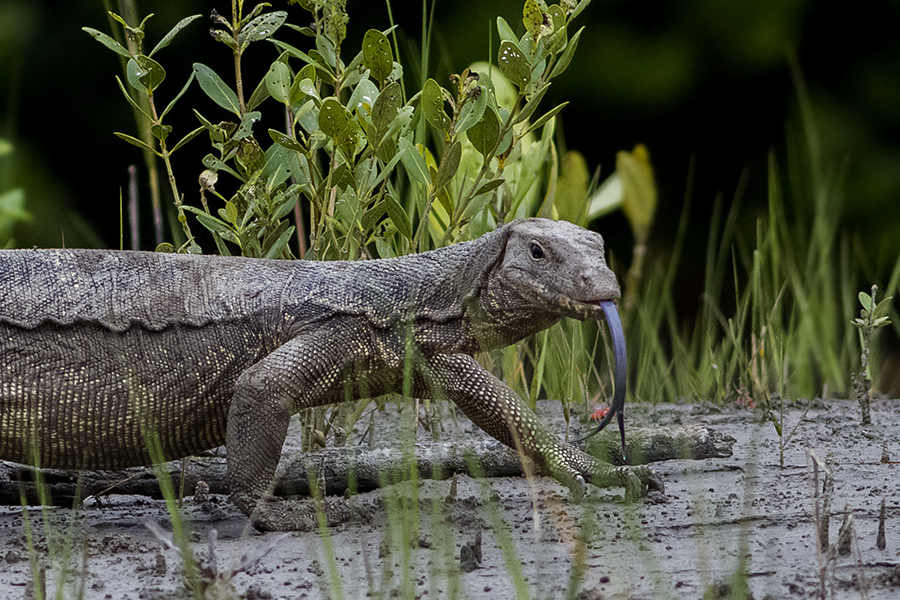
 Monitor lizard eggs have long incubation periods. Some species, like this heath monitor (Varanus rosenbergi) near Sydney, have successfully adapted to (relatively) cool regions by adopting an interesting nesting strategy. Laying their eggs within termite mounds assures a relatively constant temperature throughout incubation - these lizards are taking advantage of the architectural thermoregulation technology of a social insect. Photo: David Kirshner.
Monitor lizard eggs have long incubation periods. Some species, like this heath monitor (Varanus rosenbergi) near Sydney, have successfully adapted to (relatively) cool regions by adopting an interesting nesting strategy. Laying their eggs within termite mounds assures a relatively constant temperature throughout incubation - these lizards are taking advantage of the architectural thermoregulation technology of a social insect. Photo: David Kirshner.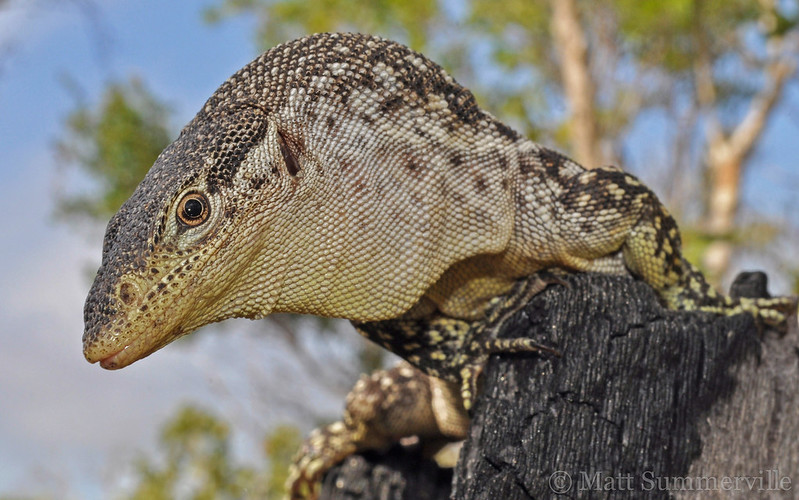

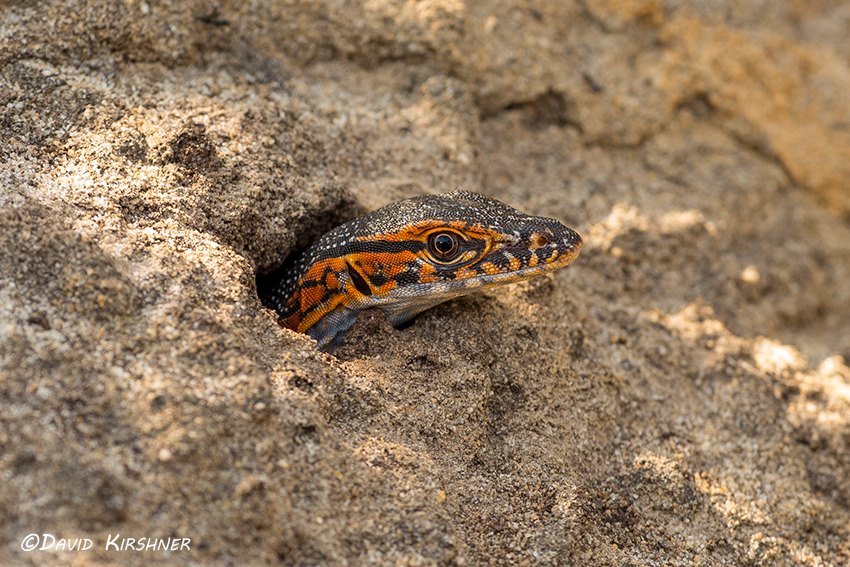
 The beautiful Kimberley rock monitor (Varanus glauerti) is one of several rock-dwelling species of monitor lizard found in northern Australia. Kimberley rock monitors are active foragers and ambush hunters that frequently feed on smaller lizards. Photo: Matt Summerville.
The beautiful Kimberley rock monitor (Varanus glauerti) is one of several rock-dwelling species of monitor lizard found in northern Australia. Kimberley rock monitors are active foragers and ambush hunters that frequently feed on smaller lizards. Photo: Matt Summerville.
